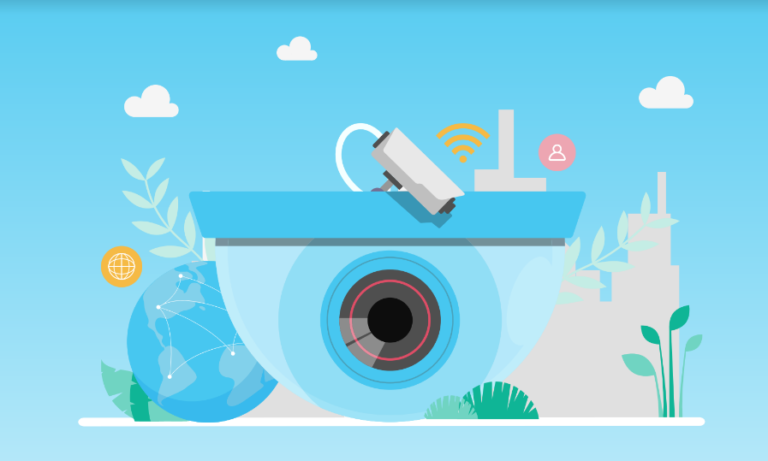Managing a fleet of physical security devices can feel like an impossible challenge at the best of times. Coupled with growing pressures from budget cuts, teams – now more than ever – must adapt and automate device management using physical security automation to keep their fleets operational and compliant while reducing costs.
The cost of manually performed operations
Enterprise reliance on connected physical security devices is growing rapidly. Companies may have hundreds to tens of thousands of connected security devices across buildings and locations around the globe. These devices—such as cameras and access control systems—are hard to properly maintain from an operational perspective.
They are also driving up costs.

Teams currently manually check, troubleshoot, and ensure the operational effectiveness of their physical security devices. This task is complex, especially when each device type can have its own management system. It can take staff days or weeks to manage its fleet of devices individually. This means that they typically struggle to stay on top of the operational status of their thousands or tens of thousands of physical security devices. The lack of integration leaves the team without a centralized view of their physical security ecosystem, highlighting the need for physical security automation. It can sometimes take weeks to discover that a device is experiencing downtime. So much so that they may not realize that a surveillance camera is down until a recording is requested. The team cannot immediately ascertain the cause even when an issue is discovered. Worse, the process of the break-fix cycle – including diagnosing and resolving the issue – takes additional time. They may need to dispatch a technician to the site, only to find that a simple reset is all that was required. These activities are time-consuming and costly and may cause the device to remain offline for extended periods.
In addition, devices situated on the IT network require their own maintenance schedule for password rotation and firmware upgrades. The manual process for these activities can take up to ten minutes per device. Multiplying that by tens of thousands of devices is impossible. Organizations that do not take the necessary routine maintenance steps as often as required increase the likelihood of device downtime in the future. Physical security automation can significantly reduce these burdens by streamlining password rotations and firmware updates.
The complexities of managing an expanded range of brands and types of physical security devices tend to overload teams. More devices from diverse manufacturers mean additional maintenance activities, requiring more manual resources to deal with incidents and physically visiting remote locations.
Organizations must find more efficient ways to keep their physical security devices operational and compliant. Physical security automation supports centralized and streamlined management processes, making the case for it strong.
The case for automation
IoTOps is a practice that allows the operational management of IoT devices to occur in a consolidated, automated, and secure manner. As reliance on manual processes becomes less and less feasible, companies have turned to IoTOps to complement their physical security and IT teams by centralizing and automating the operational management of physical security devices. Leveraging an automated solution to operationally manage physical security devices, organizations can efficiently observe, manage, and protect their devices to maximize their uptime while also helping protect those devices from cyber threats.
For example, tasks currently done manually per device — if done at all — can be automated at scale, such as password rotations, firmware upgrades, or certificate management. Automating and managing tasks from a centralized platform has been proven to cut costs and end the cumbersome, time-consuming, and error-prone activities inherent in manual processes, making physical security automation a crucial strategy for modern enterprises.
Here are examples of some of the cost benefits of physical security automation:
Fewer truck rolls and on-site visits. By remotely identifying an issue with a physical security device, companies reduce the physical on-site visits that would otherwise be necessary to resolve the issue. It also eliminates the high costs of performing routine spot checks, especially when a failure could occur immediately after the inspection.
For example, a strategically located airport achieved significant cost savings by implementing an IoTOps dashboard that sends alerts with accompanying data to identify issues immediately. Data might include whether the downtime was because of issues with a network switch or related to the device itself. Often, the device issues can be resolved automatically through the platform, such as with a remote restart of the device, eliminating the need to dispatch an engineer to investigate, thereby saving precious time and travel expenses.
Reduced manual labor. By automating most operational tasks, such as password rotations, firmware upgrades, and certificate management, companies can save significant resource expenses and free up time for more strategic and proactive tasks that could actively move the business forward.
Faster issue resolution. A centralized IoTOps platform allows for easy identification of root cause issues. With a single alert from the system, the security team can determine whether an issue is local, such as a problem with a specific device, or global, such as a weather-induced outage of the entire site. Immediate alerts save the company money and avoid any potential damage to the company’s reputation when systems don’t work.
Better decision-making. A holistic view of the physical security landscape assists with resolving recurring problems, such as identifying a faulty device before an outage occurs. In addition, future planning and decision-making are more straightforward. For example, when a device’s end-of-life time frame is clear, the organization can better plan for device replacement, including strategic purchasing and budget planning.
Cost prevention. Legal, regulatory, and liability investigations and payouts significantly threaten an organization’s cost exposure. Most employers will spend $120,000 on each workplace injury from direct and indirect costs. An effective physical security infrastructure protects against unnecessary payouts due to false claims, liability, and the cost of reputational damage.
Additionally, the cost of a cybersecurity breach can be highly damaging. Staying on top of operational tasks protects an organization from being vulnerable to a cyber-attack, which has a significant reputational impact beyond the high costs of breach recovery or ransomware fees.
Future Planning. All devices have a fixed end-of-life (EOL), end-of-service (EOS), and end-of-warranty. Having visibility into the timeline for all of your devices allows you to prepare for replacing thousands of units at once. This lets you plan and prioritize maintenance and purchasing activities, eliminating costly surprises.
Counter physical security device management costs with automation
With the ever-increasing growth and reliance on physical security devices, organizations can also expect manual upkeep costs to increase. Automating the operational management processes associated with IoT will deliver immediate visibility into the health status of all physical security devices on the network. Accessing centralized real-time data will result in dramatic cost savings from automating tasks, managing device activity via a dashboard, keeping devices operational 24/7, and managing end-of-life activities.
FAQs
What is physical security automation?
Physical security automation uses technology to automatically manage and control physical security devices such as surveillance cameras and access control systems. This approach uses software and hardware solutions to perform tasks that would otherwise require manual intervention, enhancing efficiency and reliability.
How does physical security automation improve security responsiveness?
Physical security automation enables real-time monitoring and immediate response to security incidents. Automated systems can detect anomalies, alert security personnel, and even take predetermined actions to mitigate risks without human delay, enhancing overall security responsiveness.
Can physical security automation integrate with existing security systems?
Yes, physical security automation solutions are designed to be compatible with existing security infrastructures. They can integrate with various security devices and management software, providing a unified platform that simplifies operations and enhances control over the security network.
What are the initial steps to implementing physical security automation?
Implementing physical security automation typically begins with assessing current security systems and identifying areas where automation can benefit most. A detailed plan is developed to deploy automation technologies tailored to the organization’s specific needs, ensuring seamless integration and minimal disruption.
How does physical security automation impact the role of security personnel?
While physical security automation streamlines many operational tasks, it does not replace the need for security personnel. Instead, it frees staff from routine and repetitive tasks, allowing them to focus on more complex and strategic activities. This shift can enhance job satisfaction and effectiveness, as personnel can contribute more significantly to security operations.




